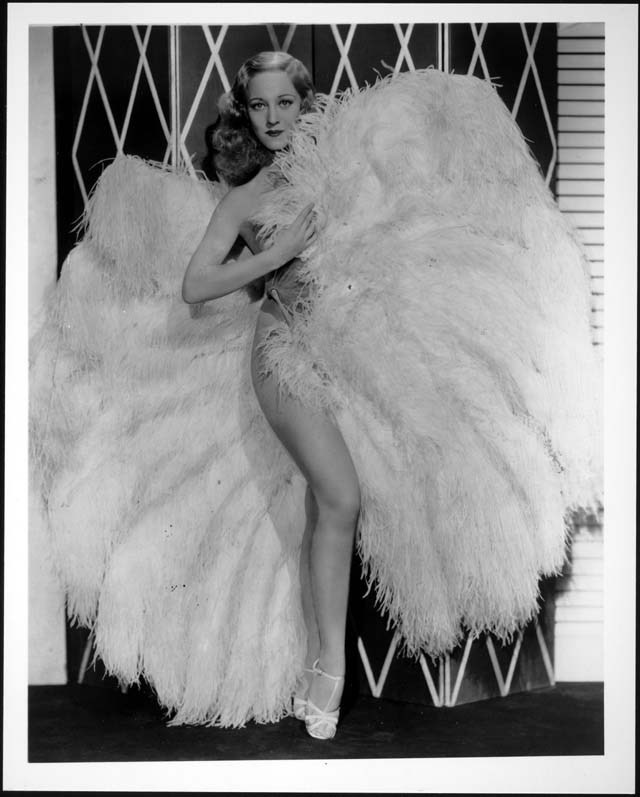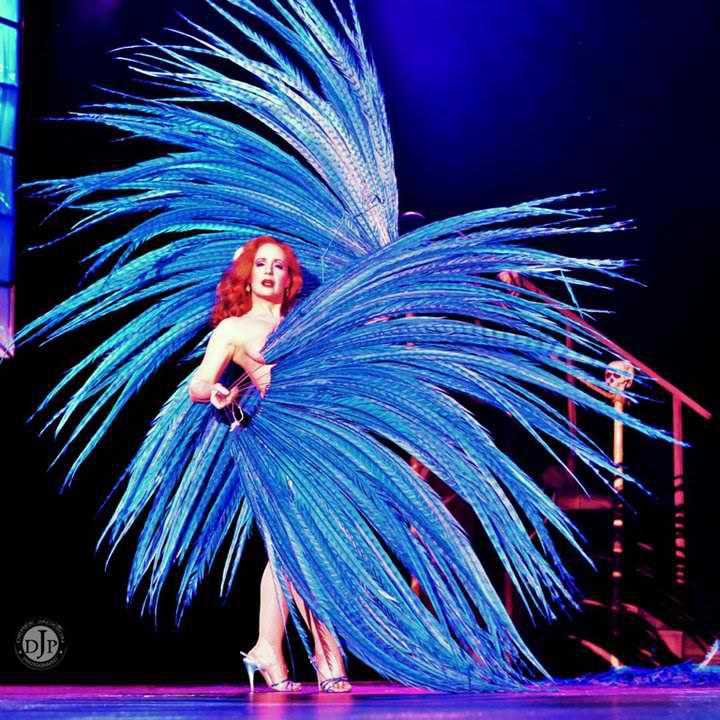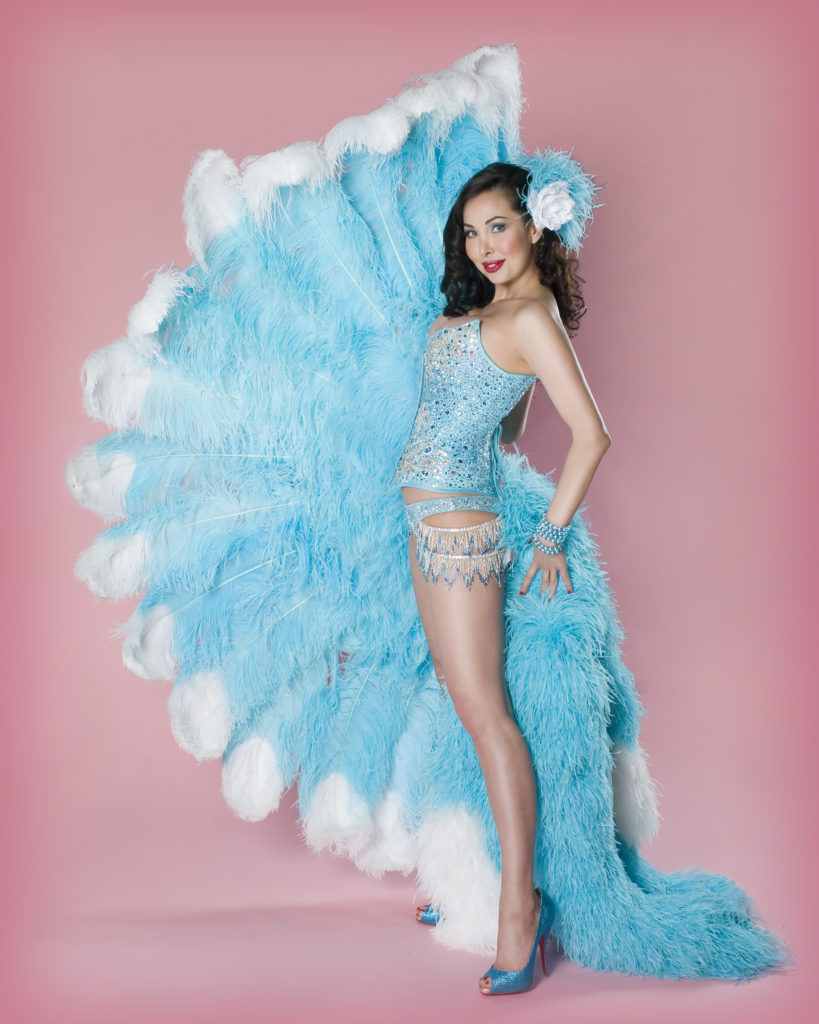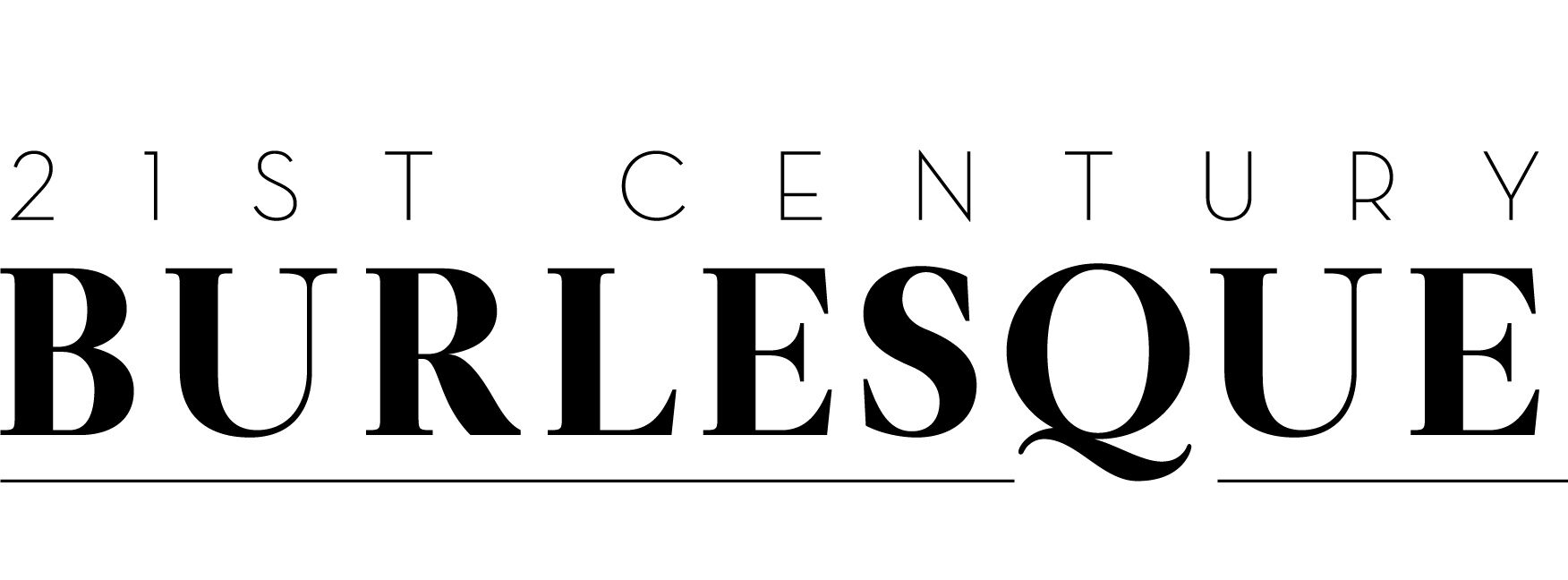Feathers embody luxury and playfulness; they are the quintessential prop and exude the very joie de vivre of burlesque. The feather fan could stand in as the visual emblem of burlesque. They are light and portable yet fill space on stage with their size and variety of grand shapes.
Feather fans are built upon the common basic folding fan design, with the earliest visual depiction dating back to the 6th Century BC. It wasn’t until Sally Rand performed her now iconic fan dance at the 1934 Chicago World’s Fair that this prop became synonymous with the world of burlesque.
This special feature is sponsored by Sublime Boudoir

This revered prop was once wielded only by a handful of ethereal trailblazers. Fans are now taught in introductory burlesque classes around the world; however, mastering this prop takes great dedication, patience, strength and grace. The innovators of fan dancing are both superstars of the neo burlesque revival and the bold innovators breaking from tradition to ascend to the highest levels of fandom.

The Beginnings and the Traditionalists
An icon of neo burlesque, Catherine D’Lish is attributed with spearheading the popularisation of fans in the revival. Catherine began making and performing with feather fans as a teenage stripper in the early 1990s and continued to perfect her craft for subsequent decades.
“Back when I made my first pair of fans, there hadn’t been anywhere near a ‘burlesque revival’ yet. I was aware of Sally Rand, and simply made some fans and started playing with them.”
Catherine says that “working with fans can be physically challenging, and it is definitely worth investing a great deal of time to improve one’s skills.”

Catherine’s influence is easily traceable through each successive generation of fan dancers. She is considered by many to be the benchmark of modern fan dancing. Her style is slow and relies on an unfaltering dedication to technique, forearm and finger strength.
Her sage advice for “anybody who wants to perform a fan dance [is to] work on it up until the point their hands feel like hamburger meat, then rest and recuperate, and then repeat this sequence until they have become one with their fans.”
While fan dancing is not unique to burlesque, the screening and shielding that fans create epitomise the playful essence of the hide and reveal that is such a central element of striptease. Australian Queen of Burlesque Imogen Kelly says that fans “are a form of screen. They are traditionally the last layer and your audience are supposed to be busting to get a glimpse of your flesh through the quills … a good fan dance has beauty and tease.”

One artist who truly employs the full potential of feather fans is Michelle L’amour. Provocative, enchanting and strong, Michelle’s Sally Rand fans tribute heralded a turning point in contemporary fan dancing. Collaborating with Cindy Garland, the mastermind behind Fancy Feathers, they reimagined the iconic prop that made Sally Rand both famous and utterly infamous.
“The Sally Rand tribute act is a very special act for me. The fans and the act kind of came up together. I was working with Fancy Feather (then it was ostrich.com) and they had these fans that they wanted me to try. They put boas on the staves instead of feathers. It was the first fan of its kind and they asked me to test it out,” says Michelle.

Cindy Garland has been working with Michelle for over ten years and says that they weren’t offering a single feather fan before the collaboration. This gap in the growing burlesque industry pushed them to go above and beyond what was being done with fans at the time.
There are now many artists worldwide who perform their own homage to Sally Rand’s fan dance, and Fancy Feather’s tribute fans are considered a benchmark for those serious about fans. If you’ve ever beheld a set, you’d know that these fans are intimidating, and the weight of them alone makes them a true mark of a dedicated artist.
Apart from practicing until your hands are “like hamburger meat”, performers need to make fans look effortless. Seattle performer Iva Handfull says that “to master fan dancing, you need to make the fans look effortless in your hands – effortless in movement, weight, and technique – no matter the size of fans. Practice your fan dance moves until your muscle memory kicks in.”

Making these giant props look effortless doesn’t happen overnight. Even Miss Exotic World 2009 Kalani Kokonuts says that she was “extremely intimidated” when first trying her hand at fan dancing. “I had a pair custom made which I just left sitting for almost two years before I would go near them. The skill level and hand strength required to properly handle the weight is enormous. It took me a year or so to gain hand strength. Even after that I would say it took me another year to get comfortable. I have large hands so that definitely helps while maneuvering them.”

While Kalani notes that her large hands help handling big fans, it takes more than just large appendages to master fans. So what does it take to make a good fan dance?
International trailblazer and Miss Exotic World 2014 Midnite Martini says that performers who wield fans masterfully make the fans become larger than life and an extension of their own bodies. “A dancer wants to be able to create that symbiotic relationship onstage, where you, the fans, the music, the costume, your heart and message are all being highlighted by each other successfully.”

Michelle L’amour says that there is a strategy behind fan dancing. “You should have a very developed body awareness before presenting an act with fans. There is a difference between someone dancing with a fan and a fan DANCER. If their arms don’t look good without the fans, the fans aren’t going to make them look better. The fans will highlight areas that need improvement, rather than mask them.”
Michelle says to remember your face and feet, since those are the body parts that get seen the most. She often tells her students to try doing their fan dancing without the fan.
Australian performer and doctor of burlesque Lola the Vamp agrees and says that “fans can do two things – they can shadow you or they can enhance you.”
Movement
Practicing and experimenting with movement is key to not allowing the prop to overwhelm new fan dancer. One of the most beautiful pieces of advice came from Imogen Kelly, who says that a performer’s movements must mimic the movement of the feathers in the fans themselves. She says to “release the control of the fans to the air.”
Movement is key to how performers present their fan dances. They can be slow, lyrical and balletic and perfectly exemplify the beauty and grace that made Sally Rand famous, or depart from this style completely and be bold, aggressive and subversive. Vicky Butterfly and Iva Handfull are two iconic performers that represent the incredible diversity of movement that can be portrayed through fans.
If we put feather fans in the hands of rock stars we would have the ‘Firestarter’ herself, Iva Handfull. Known for powerful movement and incorporating sharp electronica, Iva wields her fans as weapons. Her fierce fan work heralded a push-back to the elegantly refined choreography of previous performances and heralded a new moment in the performance of fans.
“Your personal choreography simply cannot describe your love of a piece of music. Using fans will take that choreography to the next level. You need to create new fan moves,” says Iva. “When I was choreographing my Psalm 69 routine, I threw my fans in the air to see how I could throw them and how they would land. I held onto them in different ways, such as hanging them from my fingers by the fishing line hidden in the feathers, I turned my wrists the opposite way that fans are usually held and found ways to celebrate the see-through staves versus trying to cover them up.”
Vicky Butterfly’s enigmatic Swan Bride routine integrates costume, prop and choreography to create a metamorphic transformation from swan into human. The costume utilises gauntlets augmented by feathers and larger-than-life wings.
“I wanted to combine my favourite moves and tricks of classic fan dance with moves that suggest the movements of a bird. As well as moves designed to conceal, I use a lot of more open movements that mimic the shapes and action of wings.”
Vicky says that fans “magnify the movements of the body and extend its physical presence, as well as be manipulated in ways that can make them appear to move independently of it. My aim is to help the human seem super-human!”
The Male fan dancer
Many fan dancers aim to be anything but human. Birds are a common inspiration for burlesque performers; it’s easy to see why given our obsession with feathers, and similarly, the varied shapes and actions of wings are a common inspiration for fan dancers.
Feathers often portray elements of femininity with their softness, delicacy and lilting nature, so it can be easy to forget that many of the strong backed feathers utilised in large fans come from male birds. Likewise, it is often male birds with the most eye catching and dramatic coloured feathers, so it’s rather appropriate that top boylesquers in the world Ray Gunn, Matt Finish and Captain Kidd have all presented innovative interpretations of fans which represent a different gendered perspective.

Using giant dark red pheasant feather fans, Ray Gunn’s performance at the Icons and All Stars showcase at the Burlesque Hall of Fame in 2017 brought a cataclysmic explosion of strength through the bold use of feathers in his fans. A sexually charged mating dance dubbed ‘BBC’ – the ‘Big Black Cockatoo’, he becomes the bird itself.
Ray’s strength and powerful movement wielded a different quality to feather fans – they felt sharp, an intense grrr rather than a beautiful ahhh. Ray describes his act as “the male counterpart to the types of fan dances typically seen in burlesque.”
However, it goes beyond a gendered approach. “Every aspect of the act from the type of fans, the costume, movement and music are unapologetically masculine,” says Ray.
![Jett Adore on stage at the Burlesque Hall fo Fame Weekend 2013. ©Derek Jackson [Stage Door Johnnies Post-BHoF Recap]](https://21stcenturyburlesque.com/wp-content/uploads/2013/08/jett-derek.jpg)
While Ray Gunn reflects the strong and masculine reading of fans through his movement and mannerisms, Best Boylesque 2015 winner, Matt Finish, embodies the antithesis of this gendered reading within his Judy Garland fan routine. In this performance, Matt’s movements are slow, elegant and reflective of his extensive training as a classic ballet dancer. Matt says that you have to treat your fans like a dance partner onstage.
Innovation
With so many fan dancers out there, it can be a daunting task as a performer to stand out and make a unique creative contribution to fan dancing as a specialty genre. Miss Exotic World 2016 Poison Ivory argues that, while beautiful, you cannot rely on fans alone to make a successful act. “If the fans are not adding to your act, then don’t use them at all.”
There is a lot of competition, and some artists are pushing the boundaries of convention and rethinking the prop completely.
“Fan dances are overdone by performers, so when planning a fan dance you need to really take it to the next level if you are staying in the classic genre, or else do something completely new with your fans,” says UK fan dancer Dinah Might.
Imogen Kelly encourages performers to embrace innovation. “Embrace the importance of making your fan dance special and different – and allow your peers to own their own innovations. Get interesting. Don’t copy. Be you!”
A master theatrical storyteller, Imogen Kelly was crowned Miss Exotic World in 2012 with her flamingo routine, an overload of feathers that weaves puppetry with classic fan work into a narrative courting dance to create the ultimate hide and reveal.
Construction
The basic construction of feather fans begins at the splayed out stem, which can be made from anything from bamboo to carbon fibre or acrylic with long feathers attached to the end. Fans can be made with so many different materials, such as ostrich feathers, silk, fire or solid plastic. Their potential is endless.
Midnite Martini is well known for her innovative hybrid ‘Midnite Finger Fans’. This clever combination plays upon the hide and reveal nature of fans as a prop. Starting with full feather fans, Midnite then reveals her finger fans, which are ostrich feathers affixed to the fingers of opera length gloves. The movement of the finger fans has more range of motion and creates interesting shapes and patterns.

Removing the feathers from the fans entirely is another method of deconstruction that performers can experiment with. Fans have been made from anything from fabric and lace, to L.E.D. lights or even garbage bags.
Chances are, most people won’t associate the film The Big Lebowski with fan dancing. But English performer Prudence DeVilliere utilised the traditional shape behind the fan and replaced feathers with a splay of bowling pins for her Maude Lebowski act.

“[Fans] are a staple of burlesque. So, whether an act is neo or textbook-classic, fans carry a tradition,” says Prudence. “Aside from the aesthetics, feathers have a defining reflection of how much one is willing to invest in their craft. They are not cheap, so I feel that they come tied with a perception of prestige and a display of commitment. Even for the audience member who is ignorant of costs, feathers really pack a ‘wow’ factor.”
The wow factor certainly comes into play for Catherine D’Lish, who boasts the world’s record for biggest feather fans. She says that “fans are a terrific prop that you can easily travel with – plenty of (potential) drama in a conveniently portable package.”
While keeping feather fans as they were originally intended, one New York performer decided instead to experiment with sounds of her city. Nasty Canasta performs very classic fan work, utilising many cornerstone and foundational moves, but has completely departed from the traditional soundscape of classical music and moves into the avant garde.
Nasty’s Car Alarm Fan Dance is a classic feather fan dance performed to a loop of car alarms, creating a sharp contrast between the jarring soundtrack of offensive non-musical sounds in daily life, and the classic burlesque combination of giant white fans, diamonds and pearls.
“A lot of my acts deliberately play with and against the standard vocabulary of classic burlesque: in this case, beautiful ethereal tease / mundane and deliberately off-putting noise,” says Nasty. “This act itself was created almost accidentally after literally about 36 straight hours of a car alarm going off outside my apartment.”
Final Words
Cindy Garland puts it best: “To some, [fans are] intimidating. But, if a performer has rhythm and grace or a powerful confident persona, it almost comes naturally.”
If you’re scared or overwhelmed at the idea of tackling fans, here are some words of wisdom from Catherine D’Lish: “Pick up some fans (usually two) and move them around to a bit of music. There isn’t much more to it than that!”
Burlesque Fan Dancing: Feathers and Fantasy was written by Australian burlesque performer Alyssa Kitt to mark a decade of 21st Century Burlesque magazine in 2017.




I laughed at the claim that fans are easy to travel with. What’s the secret? I’m trying to figure out how to get mine to a venue just 15 minutes away without damage.